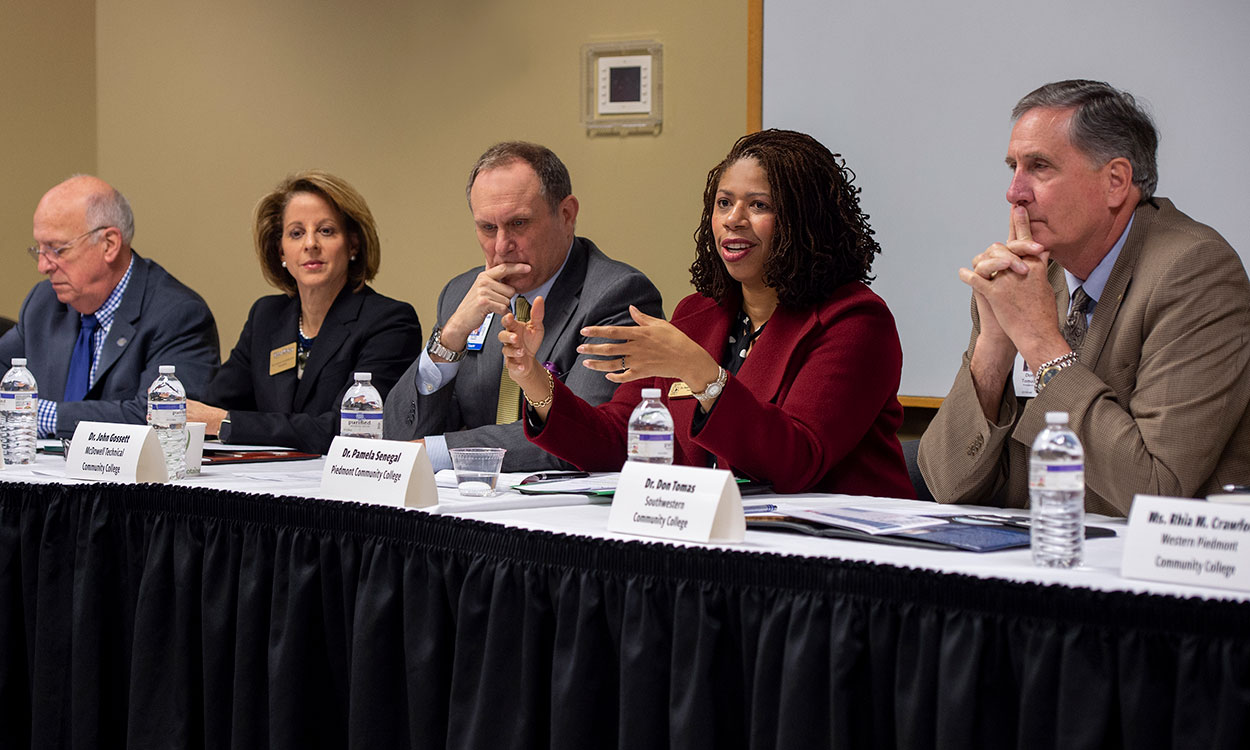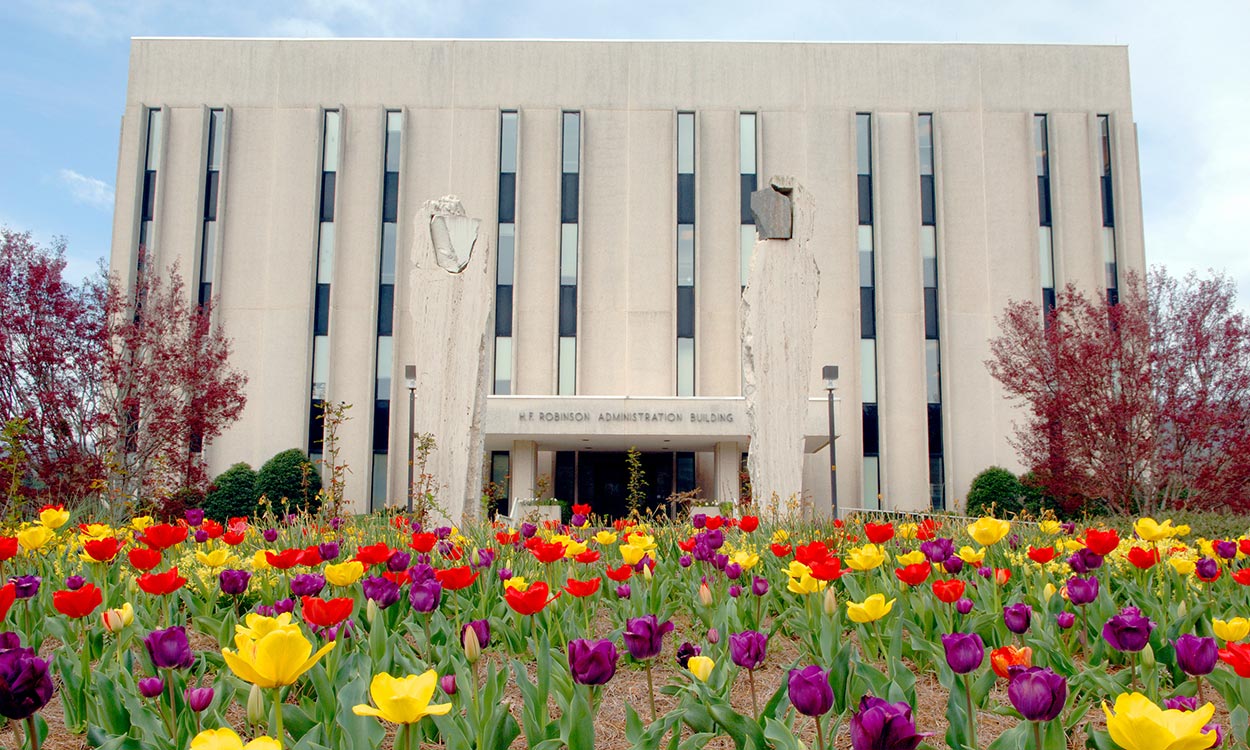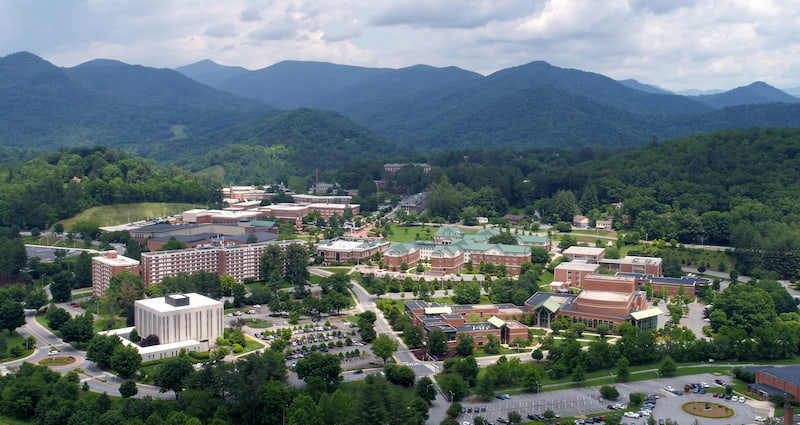Community college leaders discuss improving partnerships with WCU, other four-year schools

Community college presidents sharing their thoughts at the Feb. 13 discussion are (from left) Dennis King, Asheville-Buncombe Technical Community College; Laura Leatherwood, Blue Ridge Community College; John Gossett, McDowell Technical College; Pamela Senegal, Piedmont Community College; and Don Tomas, Southwestern Community College.
Leaders of six community colleges from across the state gathered with colleagues at Western Carolina University to discuss ways that two- and four-year institutions can work better together to provide a more seamless transition for students seeking additional higher education opportunities.
While the community college leaders concurred that WCU has been a good partner over the years through the adoption of numerous articulation agreements, dual enrollment efforts and 2+2 programs, they also agreed that more steps could be taken to remove barriers that prevent some students from transferring to a four-year institution.
The group suggested that WCU and the other two University of North Carolina System institutions that are part of the NC Promise program more robustly market to potential transfer students the enhanced affordability offered by the tuition plan. NC Promise, which went into effect for the 2018 fall semester, lowers the out-of-pocket tuition costs for North Carolina residents to $500 a semester and to $2,500 per semester for students from out of state.
The leaders also agreed that spotty high-speed internet service in rural parts of the state can hamper efforts to serve students online education, and several of them encouraged the UNC System to embrace a policy of common course numbering, which the community college system has accomplished.
The dialogue came Wednesday, Feb. 13, during a panel discussion as part of WCU’s regular Academic Affairs Council meeting. Panelists were Dennis King, president of Asheville-Buncombe Technical Community College; Laura Leatherwood, president of Blue Ridge Community College; John Gossett, president of McDowell Technical College; Pamela Senegal, president of Piedmont Community College; Don Tomas, president of Southwestern Community College; and Rhia Crawford, vice president for academic and student success at Western Piedmont Community College.
Piedmont Community College’s Senegal urged NC Promise institutions to do more to get the word out to students who may be thinking about transferring to a four-year school after completing their associate’s degrees.
“When I checked our data, we only have a handful of students who are transferring to NC Promise schools. I’d love to unpack that and figure out what’s going on,” she said. “There was a big splash about NC Promise at first, but there just hasn’t been enough ongoing marketing about this opportunity to complete a baccalaureate degree at a price that doesn’t saddle people with over $100,000 worth of academic debt. We need your help in partnering to get the word out to students to take advantage of these opportunities. The students that we serve are the ones who can least afford to take on that kind of debt as they enter the next phase of their lives.”
Blue Ridge Community College’s Leatherwood suggested community colleges and universities could do a better job informing students about 2+2 programs in which students attend a two-year institution for the first two years, then transfer to a four-year institution, resulting in students earning both associate’s and bachelor’s degrees.
“We love it when we can get those kinds of agreements. Our institutions come together, we work through the curriculum and we develop the memorandum of understanding. Then we take a picture of the chancellor and the president, we do a media blitz and, bam, we have a 2+2,” she said. “But that’s where it ends. We quit talking about it. I would like to see on the university side the encouragement of students to consider those 2+2 programs because, if you look at the success of students, they do great. We could do more to share that information out to our students.”
When asked what community college leaders look for in partnering with universities, A-B Tech’s King replied, “One word – respect.”
“Don’t be afraid of our students,” he said, pointing out that community college transfer students on average have higher GPAs as juniors than students who begin their academic careers at four-year institutions. “Our students perform admirably. They will come to you prepared. I guarantee they will come prepared.”
After reminding the group that his institution is unique because of the proximity of Southwestern Community College, with 100 or so students transferring to WCU each year, Tomas also addressed the topic of respect.
“Community colleges have always gotten a bum rap. People say, ‘You’re going to a glorified high school,’” he said, pointing out that the same organization that accredits WCU also accredits community colleges. “People say you don’t get the same education at a community college. And that’s where we go back to the common course numbering aspect, so that the students can transfer smoothly from community colleges to universities without having to re-take a course. The state of North Carolina isn’t quite there yet, but community colleges are.”
McDowell Tech’s Gossett, a 30-year veteran of the North Carolina Community College System, suggested that universities can do more to help streamline processes so that people who are not familiar with the environment of higher education feel more comfortable.
“There are some schools, which we won’t name, that it feels like they are hostile to transfers,” he said. “McDowell County is a mill town. We’ve got a mill town mentality. An awful lot of the parents of high school students don’t know what they don’t know about the bureaucracy and adminis-trivia that we force our students through. We get it. We understand the language because we use it every day. Our students do not. A lot of our students call home and there’s no help at home, because mom and dad didn’t go through all that crap either.”
Western Piedmont’s Crawford urged universities to have “clear and published” bachelor’s degree plans on their websites. “I think we need to improve the relationships between our transfer counselors and the people here at Western Carolina to make sure that students are getting correct information. I think that if we can improve those relationships, that will improve our partnership even more,” she said.
“Sometimes the hardest decision a student has to make at our school is getting out of the parking lot that first day. We have students that are terrified to come in that very first day. So, we do give them lots of support and lots of nurturing to make sure they don’t drop out,” Crawford said. “I think they are afraid sometimes when they come to the universities because it’s so big and they need that contact with someone. That’s the barrier that keeps a lot of them from coming.”
A-B Tech’s King agreed. “When a student goes from a college of our size to a larger institution, the sense of being a welcoming environment can be lost. The students can easily get lost. They need the same kind of support in that first year with you that they got from us during those first two years with us,” he said.
BRCC’s Leatherwood suggested creative scheduling to meet the demands of nontraditional students, including using WCU’s Biltmore Park instructional site for more undergraduate education. “Life gets in the way. Some of these students have children. Some of them have really good jobs, and they can’t travel to Western Carolina every day. If we could have students get classes on Tuesdays and Thursdays, they could commute those two days, take classes all day, remain employed and still live in the area. Because they are not going to move,” she said. “You could capture those students, and you’d be getting a really good, disciplined student.”
PCC’s Senegal asked colleagues to consider what long-term investments community colleges and universities must make so that people understand the opportunities that are before them, reiterating the fact that 90 percent of all residents of North Carolina are within 30 miles of at least one of the 58 community colleges in the state.
“Wouldn’t it make sense for you all to partner with us in the networks we already have in place to potentially bring some of Western Carolina to other parts of the state in specialized areas? We already have a network of ITV classrooms and we are able to simulcast courses throughout out our rural institutions,” she said. “Why wouldn’t you tap into that network in order to connect with our students. If we could think about ways to allow them to earn degrees at your institutions that allow them to stay in place and contribute locally, wouldn’t that be a win for everyone?”
Transfer students are one factor in WCU’s record-breaking enrollment, with the number of new transfer students for spring semester standing at 494, up nearly 37 percent from last spring’s total of 361.

